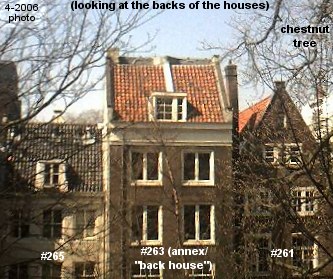 The immediate neighbors were: C. Keg�s Groothandel N.V. (a tea and coffee merchant, 265
Prinsengracht), and Elhoek Upholsterer (just to the north, at 261). (Anne Frank
House CD-ROM, and the NOID's early 2003 report)
The immediate neighbors were: C. Keg�s Groothandel N.V. (a tea and coffee merchant, 265
Prinsengracht), and Elhoek Upholsterer (just to the north, at 261). (Anne Frank
House CD-ROM, and the NOID's early 2003 report)
An "NSB" family lived around the block to the south, on Westermarkt (see Anne Frank House CD-ROM). The Critical Edition also mentions (p. 44) a report of an NSB man who lived diagonally behind the annexe, on Westermarkt, who made inquiries around the neighborhood about what was going on in that back house. Miep's book also mentions that NSB people lived across the back garden (the last page - p. 252). The Westermarkt NSB man who made inquiries was Piet Aandewiel, who died in 1945 (info sent by an Anne Frank researcher). Because many houses overlook the back garden, it is possible that Miep was referring to a second NSB neighbor.
Martha Johanna Ahler's parents (van Kuik) lived down the street, at 251 Prinsengracht.
As far as I can feebly tell from aerial photos, this house does not have
a view of the Annexe. Perhaps if one stood on the roof, one could note smoke coming
from the chimney, but I doubt even that.
Further, Martha rarely visited her parents because
they were quite estranged after she married "Tonny" Ahlers,
a violent criminal and Nazi.
At the time the
Franks first went into hiding, Martha and Tonny had been married for almost one year.
It's pure speculation, but if they visited here (say, with their baby son)
Tonny could have taken a walk into the back garden, with special interest directed
at the annexe: the
meeting(s) he had had with Otto was likely in the private office, in
the back house, which has differently paned windows than
the floors above it and the buildings next door. He could have spotted those windows and wondered where Otto had
disappeared to, if he did know that Otto had disappeared. (HLOF, p. 324, 79, xvi;
the v. Kuik name and their address was sent to me by an Anne Frank researcher)
However, the general neighborhood impression of the back house was likely quite unremarkable
because they were not overly suspicious and curious.
For example, during the war, one person was living with cousins — a family involved in the
resistance — whose house at 10 Westermarkt overlooked the back garden. She reported
that they all figured that it was a factory because the windows were so dark and it backed
a spice company. (Anne Frank House CD-ROM).
Similar to that woman's impression, the workers in the northern next door building
(Elhoek Upholsterer, 261 Prinsengracht)
would sometimes go up to the broad guttering between the two buildings to eat lunch.
Sometimes they'd hear voices, but they didn't think much of it.
(see the CD-ROM: Anne Frank House: A house with a story)
Still, because voices could be heard by others, say, a roofer on a repair call,
it was a potential danger.
There was a family living in a houseboat in the canal, directly opposite from 263 Prinsengracht. They had a small yappy dog. The man was a bargeman. They were probably quite poor, if Anne's description of the local children is any indication. They might have noticed food deliveries, events like robberies, the coming and going of people and furniture, or even people occasionally peeking out between the curtains during non-business hours. (Anne described them in her 12 Dec 1942 entry: CE p. 327-8.)